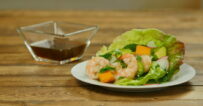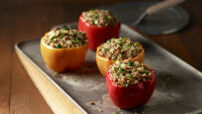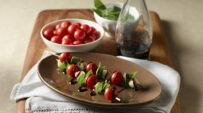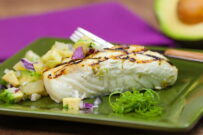
Free Heart Healthy Seafood Recipes
Teriyaki Salmon with Cauliflower Rice
Easy enough to pull off for a weeknight meal, the salmon layered onto the cauliflower rice is also impressive enough in looks and taste to serve for company. Get the free heart healthy seafood recipes below and enjoy more of your time spent together.
With only a few steps to put this nutritional and satisfying meal together, you’ll be glad you only paid 1/3 of what it costs in a restaurant while still getting all those flavors. A-Fib diets in Free Heart healthy Seafood Recipies are low in saturated fats and cholesterol plus no trans-fat.
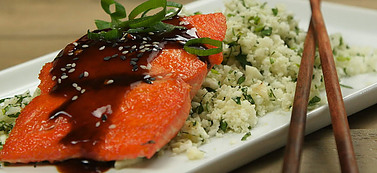
Ingredients
- 2 tablespoon low-sodium soy sauce
- 1 tablespoon water
- 1 Tbsp. dry sherry or balsamic vinegar
- 1 tablespoon sesame oil
- 1 teaspoon white vinegar
- 1/2 teaspoon no-calorie sweetener (approx. 2 packets)
- 1 teaspoon fresh minced garlic (1 large clove)
- 1 teaspoon fresh, minced ginger (about a 2-inch piece)
- 4 (6-ounce) wild salmon fillets, skin removed
- 1 head cauliflower (roughly chopped)
- 1/2 white onion, peeled and roughly chopped
- 1 teaspoon canola oil
- 1/8 teaspoon salt
- 1 cup chopped, fresh cilantro leaves
- 1 teaspoon sesame seeds
- 2 scallions (finely chopped)
Directions
- In a heatproof 8-inch by 8-inch baking pan, add the marinade ingredients: soy sauce, water, sherry, sesame oil, white vinegar, Splenda, garlic, and ginger. Use a fork to gently combine ingredients. Add salmon fillets on their side. Cover with foil and marinate in the refrigerator at least 1 hour and up to 24 hours.
- When ready to cook the salmon, remove the fish from the fridge and preheat oven to 450 degrees F.
- Meanwhile, trim and discard the leaves from the cauliflower. Roughly chop the cauliflower florets and the peeled onion. Add to the bowl of a food processor in batches, pulsing until the mixture resembles couscous. (The key to getting the correct consistency is to not overload the food processor.) Transfer mixture to a medium bowl until all the cauliflower rice has been made.
- Place the baking pan with the salmon in the preheated oven and bake until salmon is almost fully cooked, about 10 to 12 minutes, depending on thickness. Increase the heat to broil (or turn on broiler) and broil the salmon another 2 to 4 minutes to brown. Fish is done when easily flaked with a fork.
- Meanwhile, warm canola oil in a large nonstick pan over medium-high heat. Add cauliflower. Season with salt and, stirring frequently, cook until cauliflower mixture is tender, about 5 to 6 minutes. Remove from heat and stir in cilantro. Transfer cauliflower to a platter.
- Use a spatula to transfer the salmon fillets onto cauliflower. Pour teriyaki sauce from the pan over the salmon. Garnish salmon with sesame seeds and scallions. Serve.
Quick Tips
Cooking Tip: Using a Microwave is one of the quickest ways to take peeled garlic and ginger and grate it into a mince.
Keep it Healthy: Confused by the salmon choices at the seafood counter? Remember that wild salmon not only has fewer calories than farm-raised salmon but also has almost half the amount of saturated fat.
Tip: This teriyaki marinade can be used for other protein, like chicken breasts. Add marinade and 1 1/4 pounds thinly sliced skinless, boneless chicken breasts into a Ziploc bag. Marinate in the refrigerator for a few hours. Warm a large nonstick pan over medium-high heat, adding chicken, marinade, and 1/3 cup water. Saute chicken, turning frequently, until fully-cooked, about 6 to 7 minutes.
Nutrition Facts
Calories
311 Per Serving
Protein
38.2g Per Serving
Fiber
2.9g Per Serving
Tip:
When adding the Teriyaki Sauce over the Salmon
Is Teriyaki Sauce really good for you?
Asian food has become increasingly popular due to its condiments such as, soy sauce, sesame oil, siracha, hoisin sauce, oyster sauce etc…
The teriyaki sauce you buy in the store is sweet, thick and rich and goes well with meats, and its made with a mixture of sugar, honey, soy sauce, garlic, brown sugar, fruit juices such as pineapple or orange. I’m not saying it isn’t good, its delicious, but is it healthy?
All of those ingredients make it a low calorie sauce if you’re comparing it to BBQ sauce, Ranch or any of the cheese sauces.
Brown sugar and pineapple juice make the teriyaki sauce high in carbs, about 75% of teriyaki sauce’s calories come from carbs.
Teriyaki sauce is very high in sodium, but low in saturated fats and cholesterol and a good source of iron for fighting fatigue, magnesium great for blood pressure and phosphorous, good for kidneys.
Overall, its not unhealthy, if you eat it in moderation, not every day but maybe twice a week.
More Free Heart Healthy Seafood Recipes…
Tandoori Spiced Halibut with Steamed Vegetables
Free Heart healthy Seafood Recipies
This is a delicious Simple Cooking with Heart, Indian dish that’s so good you’ll want to make it again and again. And the great thing about this recipe is that its made with ingredients you probably already have in your pantry.
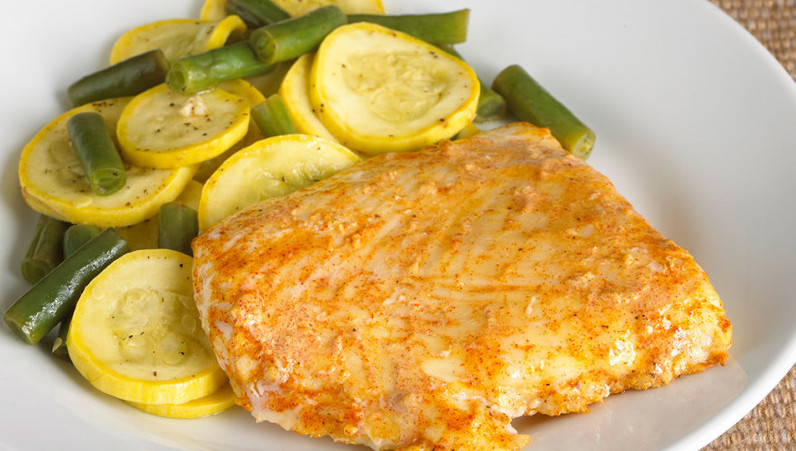
Ingredients
Steamed Vegetables
- 2 cup yellow squash (about 2 squash), thinly sliced
- 1 cup fresh green beans OR
- 8 oz. canned, no-salt-added green beans (drained, rinsed)
- 1 clove garlic (minced)OR
- 1 tsp. Jarred, minced garlic
- 1 tsp. Fresh, or, jarred lemon juice
- 1/2 tsp. Black pepper
- non-stick Cooking spray
Tandoori Spiced Halibut
- 2 cup fat-free, plain Greek yogurt
- 1/4 cup fresh or jarred lemon juice (about 2 lemons)
- 2 Tbsp. Cumin or gram Marsala (Indian spice)
- 1/4 cup cold water
- 2 Tbsp. Paprika
- 2 Tbsp. Fresh ginger (peeled, minced)OR
- 1 Tbsp. Dried ginger
- 5 clove fresh garlic (minced)OR
- 2 Tbsp. Jarred, minced garlic
- 2 tsp. Yellow curry
- 1 tsp. Black pepper
- 2 lb. filet Halibut, cut into 4oz.each (can substitute cod, tilapia, grouper, or snapper)
Directions
Steamed Vegetables
- In a mixing bowl, combine squash, beans, garlic, lemon juice and black pepper. Make a pouch for steaming the vegetables by placing two pieces of aluminum foil (big enough to hold vegetables) side by side. Spray one sheet with cooking spray and place vegetables on top. Place the second piece of foil over the vegetables and fold edges of top and bottom foil pieces to create a sealed pocket around vegetables. Place on baking sheet and bake for 20 minutes.
- Very carefully open pouch of steamed vegetables. Steam will release when pouch is opened and will be very hot. Serve alongside fish.
Tandoori Spiced Halibut
- Preheat oven to 375°F.
- In a mixing bowl, combine yogurt, lemon juice, water, cumin (or gram Marsala), paprika, ginger, garlic, yellow curry and black pepper. Place fish fillets in yogurt mixture so they are completely covered. Cover and set in refrigerator for 30-45 minutes.
- Remove fish from marinade, gently wiping off excess yogurt, leaving only a thin coating on fish. Discard remaining marinade. Place fish fillets in a baking dish coated with cooking spray. Bake for about 12 minutes, just until fish begins to flake apart slightly.
Quick Tips
Tip: Double this recipe and make fish tacos with Asian Cole Slaw.
Nutrition Facts
Calories
130 Per Serving
Protein
24g Per Serving
Fiber
1g Per Serving
Cost Per Serving
$4.76
Tip:
Why is Halibut Healthy for You?
Halibut is an excellent source of selenium, a trace mineral with many health benefits that your body need in small amounts. A cooked half-fillet (160 gms) of halibut, which is the recommended serving size provides over 100% of your daily dietary needs.
The strong fish is high in heart healthy omega-3, a good source of protein, delivering 20 grams in a 3 ounce fillet.
Halibut is a high quality source of protein that can contribute to your total protein needs. Heart disease is the leading cause of death in men and women worldwide. Halibut contains a variety of nutrients that are good for your heart, such as omega-3, fatty acids, selenium, magnesium, Niacin, Vitamin B6 and B12.
Protein is made up of amino acids, which are involved in almost every metabolic process of your body. You should be getting enough protein for various reasons. It can help build and repair muscle, suppress appetite, aid in weight loss and more.
Fish and other animal proteins are considered high-quality, complete proteins. That means they provide all the essential amino acids your body cannot make on its own.
Spinach-Stuffed Baked Salmon
This dish, rich in omega-3 fatty acids and full of Mediterranean flavors, can be on your table in 30 minutes.
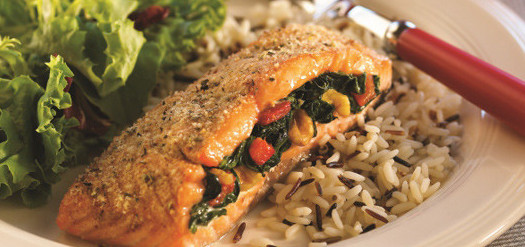
Ingredients
- 1 teaspoon olive oil (extra virgin preferred)
- 2 ounces spinach
- 1 teaspoon grated lemon zest
- 1/4 cup chopped roasted red bell peppers, rinsed and drained if bottled
- 1/4 cup fresh basil, coarsely chopped
- 2 tablespoons chopped walnuts
- Cooking spray
- 4 salmon fillets (about 4 ounces each)
- 2 tablespoons Dijon mustard (lowest sodium available)
- 2 tablespoons plain dry bread crumbs (lowest sodium available)
- 1/2 teaspoon dried oregano, crumbled
- 1/2 teaspoon garlic powder
- 1/8 teaspoon pepper
Directions
- In a large skillet, heat the oil over medium heat, swirling to coat the bottom. Cook the spinach and lemon zest for 2 minutes, or until the spinach is wilted, stirring constantly. Transfer to a medium bowl. Stir in the roasted peppers, basil, and walnuts. Let cool for 5 minutes.
- Preheat the oven to 400°F. Line a baking sheet with aluminum foil. Lightly spray the foil with cooking spray.
- Cut a lengthwise slit in the side of each fillet to make a pocket for the stuffing. Be careful to not cut through to the other side. With a spoon or your fingers, carefully stuff a scant 1/2 cup spinach mixture into each fillet. Transfer to the baking sheet. With a pastry brush or spoon, spread the mustard over the fish.
- In a small bowl, stir together the remaining ingredients. Sprinkle over the fish. Lightly spray the top with cooking spray.
- Bake for 12 to 13 minutes, or until the fish is the desired doneness and the filling is heated through.
Nutrition Facts
Calories
208 Per Serving
Protein
27g Per Serving
Fiber
1g Per Serving
Tip:
Is Spinach Stuffed Baked Salmon Healthier than Halibut?
Spinach Stuffed Baked Salmon is loaded with omega-3 fatty acids and full of Mediterranean flavors, so easy to make it can be on your dinner table in 30 minutes. If you read the Tip above, halibut and salmon are quite, different even though they both have huge benefits.
Salmon is healthier than halibut because it contains almost 8 times more heart healthy omega-3 fatty acids. Salmon also contains a higher number of vitamins and minerals and is lower in mercury than halibut.
Salmon is richer in Vitamin B1, B2, B6, B12, B3, B5, Copper, Potassium and Folate. Halibut contains 2 times more Saturated Fat than salmon.
Salmon is lower in sugar, sodium, Saturated Fat, and minerals. Halibut is lower in cholesterol and price.
Even though Salmon has the edge, halibut is a wonderful fish to cook in an assortment of ways.
Spring Greens with Salmon and Apricot-Ginger Vinaigrette
This crunchy combination of spring greens, baby spinach, red cabbage, and snow peas is powered up with salmon and topped with a sweet apricot-ginger vinaigrette.
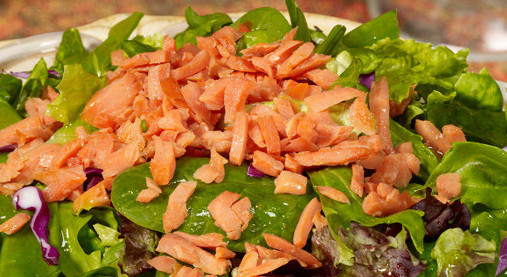
Ingredients
Apricot-Ginger Vinaigrette
- 1/4 cup all-fruit apricot spread
- 1/4 cup fresh orange juice
- 2 tablespoons white wine vinegar
- 1 teaspoon sugar
- 2 teaspoons grated, peeled ginger root
- 1/8 teaspoon crushed red pepper flakes
- 1/8 teaspoon salt
Salad
-
- 4 cups mixed salad greens (spring mix preferred), torn into bite-size pieces
- 2 cups baby spinach leaves
- 1 cup shredded red cabbage
- 1 cup fresh or frozen snow peas, trimmed and halved diagonally if fresh, thawed if frozen
- 1 7.1-ounce vacuum-sealed pouch pink salmon
Directions
- In a food processor or blender, process all the vinaigrette ingredients until smooth.
- Put the salad ingredients except the salmon on a serving platter. Pour the vinaigrette over the salad. Toss gently. Crumble the salmon on top. Serve immediately for peak flavor and texture.
Quick Tips
Tip: Freezing ginger root keeps it fresher longer and makes it easier to peel and mince. Wrap the unpeeled root in aluminum foil and freeze it for up to six months. When you’re ready to use it, remove the root from the freezer and peel it with a paring knife or vegetable peeler. Grate it with a rasp grater. Or, you can slice the frozen root and use a rotary grater to mince a large quantity in no time.
Nutrition Facts
Calories
128 Per Serving
Protein
11g Per Serving
Fiber
3g Per Serving
Tip:
Nutritious Health Benefits of Apricots
Apricots (Prunus armeniaca) are stone fruits also known as Armenian plums. Round and yellow, they look similar to a smaller version of a peach but share the tartness of purple plums.
Apricots are a decent source of beta carotene, lutein and zeaxanthin, all of which are potent antioxidants that help fight free radicals in your body.
It’s best to enjoy apricots whole and unpeeled, as the skin boasts large amounts of fiber and nutrients. Apricots are low in calories and fat while also an excellent source of vitamins A and C.
The main flavonoids in apricots are chlorogenic acids, catechins, and quercetin. These compounds work to neutralize free radicals, which are harmful compounds that damage your cells and cause oxidative stress. Oxidative stress is linked to obesity and many chronic diseases, such as heart disease.
Apricots are very nutritious and low in calories. They are high in antioxidants that promote eye health and digestion, boost skin health and gut health. Apricots are high in potassium and protect your liver. They are easy to add to any diet and most of all, they’re delicious.
Shrimp Mushroom and Asparagus Stir Fry with Couscous
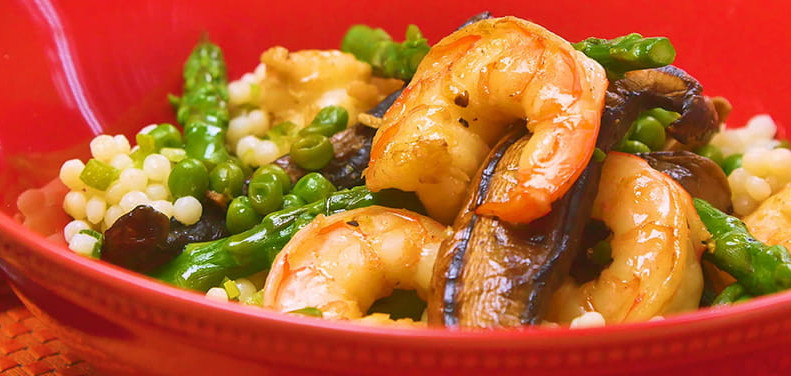
With just a 10-minute cooking time that’s not even on the stove top, couscous deserves space as a pantry staple. This meal is overflowing with shrimp, portobello mushrooms, and asparagus but other stir-fry favorites like snow peas and sliced water chestnuts could also be incorporated and need a cooking time of just a couple minutes.
Ingredients
- 2 large cleaned, cut into 1-inch pieces portobello mushrooms
- 1 bunch asparagus spears (cut into 2-inch pieces)
- 1 tablespoon fresh, minced ginger
- 2 teaspoons fresh, minced garlic
- 1 pound large shrimp (peeled and deveined, tail removed)
- 1/3 cup boiling water
- 2 tablespoon sesame oil
- 2 tablespoon low-sodium soy sauce
- 2 tablespoon 100% orange juice
- 3/4 cup dry couscous
- 1/2 cup scallions
- 3/4 cup boiling water
- 3 teaspoons canola oil (divided)
- 1 cup frozen peas
Directions
- Prepare the vegetables: Clean the portobello mushrooms by removing and discarding each stem. Use a spoon to scrape the black gills from the underside of each mushroom; discard gills. Slice each mushroom into 1-inch pieces. Snap the ends off each asparagus spear and cut into 2-inch pieces. Next, peel and mince the ginger; mince the garlic too.
- Prepare the shrimp by peeling, deveining, and removing the tails. Prepare the sauce by mixing the 1/3 cup water, sesame oil, soy sauce, and orange juice into a small bowl.
- Bring 1 cup of water to a boil either in a teapot or in the microwave. Add couscous and scallions into a medium bowl. Stir in the boiling water and top with a lid or cover with foil. Let sit at least 10 minutes.
- Meanwhile, warm 1 teaspoon oil in a large nonstick pan or wok over high heat. Add mushrooms; stir and saute; just briefly, about 2 minutes. Add asparagus; saute, stirring constantly, until mostly tender, about 3 minutes. Stir in peas, cooking 1 to 2 minutes until warm. Remove from heat and transfer vegetables to a plate.
- Warm 2 teaspoons oil again in pan or wok over medium-high heat. Add ginger and garlic, stirring constantly and cooking until fragrant, about 30 seconds. Add shrimp, sauteing constantly until the shrimp are almost fully cooked, about 2 minutes. Pour in the soy sauce mixture along with reserved vegetables, quickly stirring together to combine. Remove from heat.
- Use fork to fluff the couscous. Serve stir-fry over the couscous.
Quick Tips
Cooking Tip: The key to a stir-fry is to chop all the ingredients in advance. A stir-fry is cooked very quickly, so there’s no time to pause to finish chopping.
Keep it Healthy: Portobellos are a hearty mushroom that many think can make an adequate substitute for meat. So consider the portobello as a meat fill-in for upcoming meals-whether grilling it whole to use like a burger or stuffing it with grains and vegetables.
Tip: Can’t find cleaned shrimp? Use kitchen shears to quickly prepare them-simply cut through the shell lengthwise from the top of the shrimp down to both devein the shrimp and help remove the shell all in one swoop. If the shrimp are peeled, I take the point of a wooden skewer and run it down the vein to remove it easily, then squeeze the tail and pull, it comes right off!
Nutrition Facts
Calories
382 Per Serving
Protein
32.4g Per Serving
Fiber
6.4g Per Serving
Tip:
Shrimp, is it Healthy for You?
Shrimp is low in calories yet rich in nutrients. Adding shrimp to a stir-fry is an easy way to increase your intake of the heart healthy omega-3 fatty acids found in seafood. Cook about a pound (450 mg) of peeled and deveined shrimp n 1 tablespoon of oil until it turns pink, about 2-3 minutes per side.
Shrimp is one of the most commonly consumed types of shellfish. It’s quite nutritious and provides high amounts of certain nutrients such as, iodine, that aren’t abundant in many other foods. Iodine is required for proper thyroid function and brain health.
Yes, shrimp is high in cholesterol
However, research shows this may not be the case for most people, as only a quarter of the population is sensitive to dietary cholesterol. For the rest, dietary cholesterol may only have a small impact on the blood cholesterol levels.
This is because most of the cholesterol in your blood is produced by your liver, and when you eat foods high in cholesterol, your liver produces less.
Author Commentary
Shrimp contains antioxidants.
The primary type of antioxidants in shrimp is a carotenoid called astaxanthin. It’s a component of algae, which is consumed by the shrimp. For this reason, shrimp is a major source of astaxanthin. In fact, this antioxidant is responsible for the reddish color of shrimp cells.
When you consume astaxanthin, it may help protect against inflammation by preventing free radicals from damaging your cells. It’s been studied for its role in reducing the risk of several chronic diseases.
Some shrimp are shipped from other countries to the United States. In the U.S. it is illegal to use antibiotics in shrimp mostly because it may lead to antibiotic resistance, which can cause outbreaks of diseases that do not respond to antibiotic treatment.
“Farm-raised shrimp from some countries may be contaminated with antibiotics. To reduce your antibiotic exposure, it’s best to purchase wild-caught or farmed shrimp from countries where antibiotic use is illegal.”
Thank you for stopping by.
I hope you found something delicious on this page. Healthy eating prevents heart disease, enjoy. Please feel free to leave a comment below, your opinion matters to me.
Wish you well, Sherry
